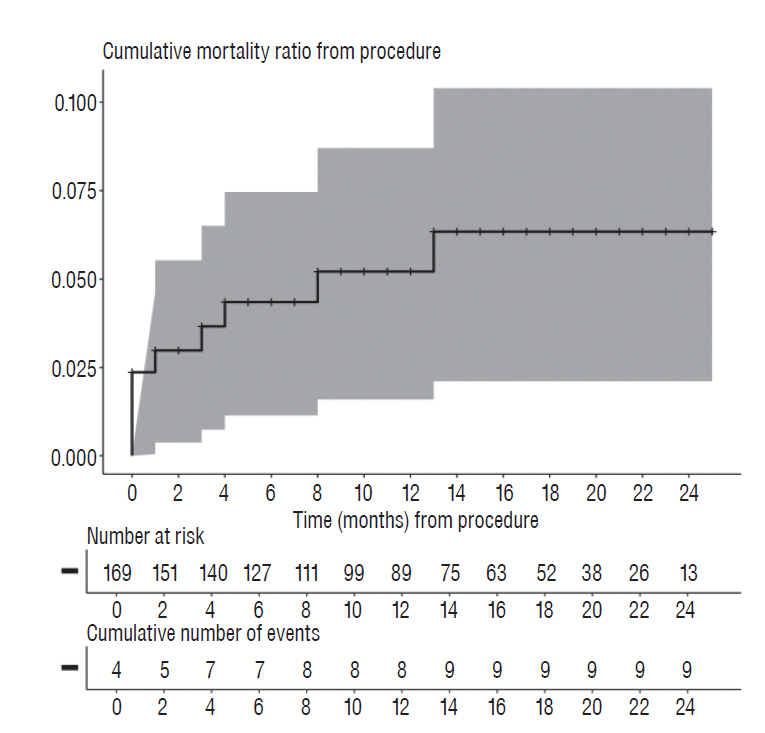J Korean Neurosurg Soc.
2018 Mar;61(2):219-223. 10.3340/jkns.2017.0218.
Nationwide Mortality Data after Flow-Diverting Stent Implantation in Korea
- Affiliations
-
- 1Department of Neurosurgery, Seoul National University Bundang Hospital, Seongnam, Korea. kwonoki@snu.ac.kr
- 2Seoul National University College of Medicine, Seoul, Korea.
- 3Center for Preventive Medicine and Public Health, Seoul National University Bundang Hospital, Seongnam, Korea.
- KMID: 2408023
- DOI: http://doi.org/10.3340/jkns.2017.0218
Abstract
OBJECTIVE
To investigate nationwide statistics on flow-diverting stent usage for cerebral aneurysm treatment and related mortality data.
METHODS
We requested data extraction from the National Health Insurance Service claims database using electronic data interchange codes (J3207064, J3207073). Patient and hospital information as well as death statistics were collected from the database.
RESULTS
A total of 169 procedures were performed using flow-diverting stents for cerebral aneurysm treatment from November 2014 to December 2016 in Korea. The majority of primary diagnosis was unruptured intracranial aneurysm. During the study period, nine subjects died, including one patient initially diagnosed with subarachnoid hemorrhage. The crude mortality rate was 5.3%. Five patients died within one month after the procedure; therefore, the estimated periprocedural mortality rate was 3.0±1.3%. The mortality rate as of the last day of 2016 was 6.3±2.1%.
CONCLUSION
In a 171 person-year follow-up in a Korean series, nine deaths occurred after flow-diverting stent treatment. The crude mortality rate in Korea (5.3%) was higher than that reported in a previous meta-analysis (3.8%).
MeSH Terms
Figure
Cited by 1 articles
-
A Newly-Developed Flow Diverter (FloWise) for Internal Carotid Artery Aneurysm: Results of a Pilot Clinical Study
Byung Moon Kim, Keun Young Park, Jae Whan Lee, Joonho Chung, Dong Joon Kim, Dong Ik Kim
Korean J Radiol. 2019;20(3):505-512. doi: 10.3348/kjr.2018.0421.
Reference
-
References
1. Becske T, Brinjikji W, Potts MB, Kallmes DF, Shapiro M, Moran CJ, et al. Long-term clinical and angiographic outcomes following pipeline embolization device treatment of complex internal carotid artery aneurysms: five-year results of the pipeline for uncoilable or failed aneurysms trial. Neurosurgery. 80:40–48. 2017.
Article2. Byoun HS, Huh W, Oh CW, Bang JS, Hwang G, Kwon OK. Natural history of unruptured intracranial aneurysms : a retrospective single center analysis. J Korean Neurosurg Soc. 59:11–16. 2016.
Article3. Fiorella D, Woo HH, Albuquerque FC, Nelson PK. Definitive reconstruction of circumferential, fusiform intracranial aneurysms with the pipeline embolization device. Neurosurgery. 62:1115–1120. discussion 1120–1111. 2008.
Article4. Kim T, Lee H, Ahn S, Kwon OK, Bang JS, Hwang G, et al. Incidence and risk factors of intracranial aneurysm: a national cohort study in Korea. Int J Stroke. 11:917–927. 2016.
Article5. Molyneux A, Kerr R, Stratton I, Sandercock P, Clarke M, Shrimpton J, et al. International subarachnoid aneurysm trial (ISAT) of neurosurgical clipping versus endovascular coiling in 2143 patients with ruptured intracranial aneurysms: a randomised trial. Lancet. 360:1267–1274. 2002.
Article6. UCAS Japan Investigators, Morita A, Kirino T, Hashi K, Aoki N, Fukuhara S, et al. The natural course of unruptured cerebral aneurysms in a Japanese cohort. N Engl J Med. 366:2474–2482. 2012.
Article7. Ye G, Zhang M, Deng L, Chen X, Wang Y. Meta-analysis of the efficiency and prognosis of intracranial aneurysm treated with flow diverter devices. J Mol Neurosci. 59:158–167. 2016.
Article
- Full Text Links
- Actions
-
Cited
- CITED
-
- Close
- Share
- Similar articles
-
- A Case of Migration of Pipeline Embolization Device Causing Rupture during Treatment of an Unruptured Vertebral Artery Dissecting Aneurysm
- Delayed Proximal Flow Diverting Stent Migration in a Ruptured Intracranial Aneurysm: A Case Report
- Retreatment of a recurrent giant aneurysm of the internal carotid artery after treatment with a flow-diverting stent
- Symptomatic Post Endarterectomy Common Carotid Artery Pseudoaneurysm Treated with Combination of Flow Diverter Implantation and Carotid Stenting
- A Case of Complete Resolution of Aortic Dissection in the Descending Thoracic Aorta Treated with Endovascular Stent-Graft Implantation


